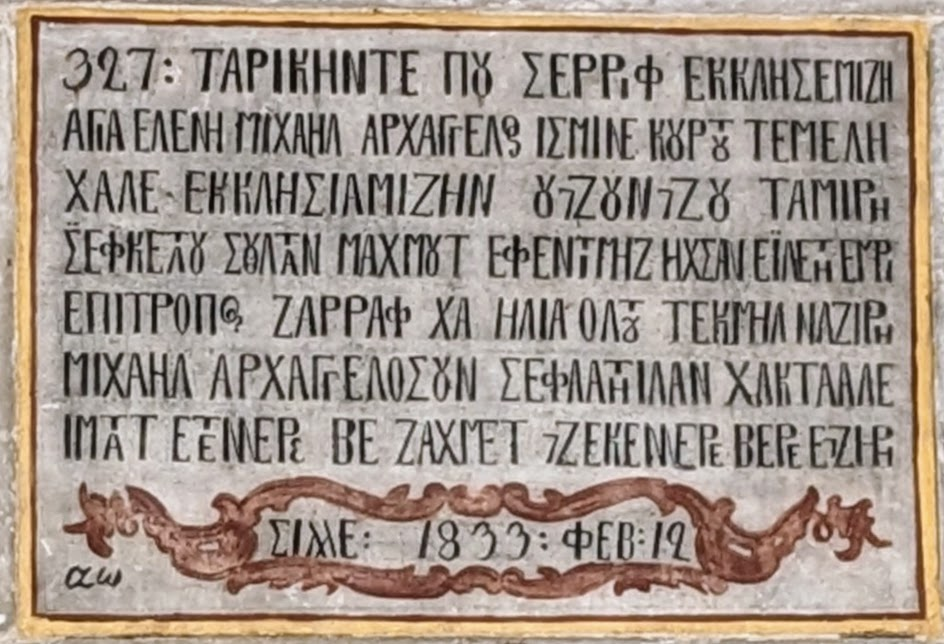My wife and I visited Konya, May 2023. Never having been to Konya before, we decided to hire a guide for an all-day walking tour, including an excursion to the village of Sille, just west of Konya. Sille was inhabited by Christian Greeks who had lived there in peaceful coexistence with the Muslim Turks of Konya for over 800 years.
Konya is best known for Jalal al-Din Muhammad Rumi, founder of the Mevlevi Dervish order. In addition to Persian, Rumi wrote Greek poems using the Arabic script, while Greek Sille villagers wrote Turkish using the Greek alphabet.
Our guide Fatıma took us out to the nearby village of Sille, where we visited the old Aya Eleni church, now a museum. Fatima told us that a plaque over the entrance was in Turkish, written in Greek characters. If she hadn’t mentioned the inscription, I would never have guessed.

I am both a Near East Languages major (U. of Michigan, 1968, Turkish, Osmanlıca, and Arabic) and a librarian (UCLA, 1972). I briefly pursued a PhD in Ottoman history before realizing that I would likely be unemployable — as were most of my fellow grad students. I enjoy challenges, cryptography, and puzzles, especially ones that involve the way languages shift and evolve over time and across cultural boundaries. Ever since our return from Türkiye, the inscription from the old church in Sille had been gnawing at me.
In mid-June I decided to see if I could translate it. I don’t know Greek, and I recognize only a few letters, but I could see that the inscription began with a date 323: Tarihinde, and ended with another date: Sille: 1833: Feb 12. Between those two dates I could make out a few words, such as Aghia Eleni, but not much more.
I reached out to an old friend in Istanbul, a professional translator. She replied: “It’s Greek to me.”
Before I started pulling out my hair trying to transliterate the Greek letters of the inscription, I did some Google searches, and found that:
1. The language is Karamanlı Turkish.
2. Allegedly, the church was built by Helena, the mother of Emperor Constantine, during her pilgrimage to Jerusalem in 327.
Karamanlı Turkısh is a dialect of the Turkish language that was used in the Turkish province of Karaman, as well as in Greece, Bulgaria, North Macedonia, and Romania. Although Ottoman Turkish (Osmanlıca) was written in the Arabic script, Karamanlı Turkish used the Greek alphabet.
Continuing down the rabbit hole of internet searching, I found a post about the Aya Eleni church by a Turk who lives in Utrecht, Netherlands, and who works as a computer programmer/web developer. He provided this translation:
327: This Serif established our church in the name of Aghia Eleni Mikhail Arkhangelos. The third restoration of our churh was realized by order of our majesty Sultan Mahmut and finished under the supervision of Epitropos goldsmith XA (Hacı) Elia, and by the intercession of Mikhael Arkhangelos. May God reward those who seek his help and take paints.
Sille 1833: Feb 12
Source: https://www.aahmetyildiz.com/aya-elenia-church-museum/
Aside from the typos, It seemed like an inelegant translation, and I had the hubris to think I could do better, but I needed a transliteration of the Greek characters — something I didn’t think I was up to.
I reached out to Thomas Milo in the Netherlands. Tom is the world’s leading expert on computerized Arabic typography, and has studied various Turkic languages, Arabic, Macedonian, and Russian. He sent me what he called a “quick and dirty” transliteration:
327 Tarikinde bu şerrif ekklisimizi Aya Eleni Mihail Arhangelu ismine kurtu temeli hale ekklisimizin üçünüzü tamiri şevketi Soldan Mahmut Efendimiz ıhsan eyledi Emri Epitropu zarraf ha ilia oldu tekmil naziri Mihail Arhangelosun selfantilan hakta ale imdat edemere ve zahmet çekenere vere eçiri.
While Tom was composing his reply, I saw a photo of Haghia Elenia in a Wikipedia article on Karamanlı Turkısh. Prof. Francesco Mazzucotelli, who teaches history of Turkey and the Near East at the State University of Pavia in Italy, wrote a caption to the photo in which he provided a more detailed transliteration, with glosses that were even more helpful:
327: Tarihinde bu serrif (şerif) ekklisemizi (kilisemizi) Agia Eleni Mihail Arhangelos ismine kurdu temeli / hale ekklisiamizin (kilisemizin) üçüncü tamiri / Şefketlu Sultan Mahmud efendimiz ihsan eyleti emri / Epitropos Zarraf Xa (Hacı) Ilia oldu tekmil nazırı / Mihail Arhangelos’un sefaatiilan (şefaatı ile) Hak Taale / imdat edenlere ve zahmet çekenlere vere eciri.
Sille 1833 Feb 12
Considering that this text dates from 1833, it was surprisingly readable, closer to modern Turkish than to the Ottoman court language. Since I no longer had to struggle with the Greek alphabet, I could focus on the Turkish words. I eventually came up with this translation of what I think conveys the meaning, rather than the literal words of the inscription. Thank you to the many people who have attempted to teach me languages other than my native English since 1962:
This noble church of ours was established in 327 by Saint Helena in the name of Archangel Michael. The third restoration of our church was ordered by Our Majesty Sultan Mahmut, and was completed under the direction of the esteemed custodian Zarraf, with the intercession of the Archangel Michael. May God reward those who seek his help and take pains.
Sille: 1833: Feb 12
Initially, I left out Epitropos Xa (Hacı) because it seemed unlikely that someone with a Greek name like that would be a convert to Islam and a pilgrim to Mecca. A friend in Istanbul pointed out that haci can apply to both Christian and Muslim pilgrims. Professor Mazzucotelli pointed out that haci can be used as a title of respect, and also that epitropoß also means custodian.
Looking back to my days in college, it’s impossible to imagine solving this riddle in less than weeks or months — if at all. The internet has changed research forever.









